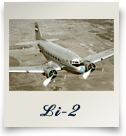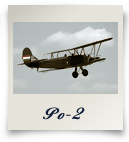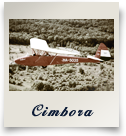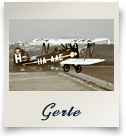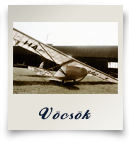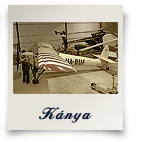
So, production re-started in 1946, the first aircraft was completed in 1948. The original plan included an English made four cylinder in-line engine, however, the political situation at that time did not allow the purchase of the engine. Instead, a Czechoslovakian made four cylinder, in-line, 130 HP Walter - Major I. engine was installed spinning a two blade, fix, wooden propeller. This aircraft became part of the newly established Hungarian Air Force with the military registration number 1-002. Later, the Air Force received more modern training aircrafts in a larger quantity in 1949, thus this aircraft became a sports plane and was given a civilian registration of HA-RUA.
The professionals showed an interest in and expressed appreciation of this nicely made aircraft having good aerodynamic characteristics. Despite of all the above, when the first Kánya towed a glider from a short field, started a turn too early, then slipped sideways and became damaged. It was taken then apart, brought back home, and became a static display in Dunakeszi for training technicians.
Based on the experience gained from the first aircraft of this kind, a few modifications were made, i.a. the cockpit became wider in the aft, so the seat for the third passanger became a bit more comfortable. This second aircraft, also with Walter - Major I. engine and fix propeller was registered as HA-RUB, and was used in the Hungarian sports aviation as "B KÁNYA" between 1949 and 1954. At that time, it flew to Székesfehérvár, where a towing exercise ended on a corn field. The aircraft damaged and was scrapped.
The third version, "C KÁNYA", was built in 1952, registered as HA-RUC. With its unrounded doors and six cylinder 160 HP Walter - Minor engine, it was different from its forerunners. For the sake of test, this aircraft received a two blade metal propeller with adjustable pitch from Czechoslovakia, but it did not prove. Thus, this plane and all the later ones were released with fix, wooden propellers manufactured in Esztergom by Márton Papp's plans. Originally, HA-RUC was designed for three persons, however, later a 120 l fuel drum replaced the aft seat. This fuel tank was used in "Fecske" (Swallow) aircrafts. The later Kányas were manufactured with this modification included.
The prototype of "C KÁNYA" towed throughout 1953, and the experience gained based the production of a six aircaft series. The aircrafts were manufactured in 1953-54 and were registered from HA-RUD to HA-RUI. So, excluding the aircraft not completed during the war, the three Kánya versions count alltogether 9 pieces. One of them, registered as HA-RUE, was converted to winter operation, and was based in Budaörs on skis.
Frequent engine failures necessitated the purchase of some more reliable engine. The solution was the M-11D five cylinder air cooled radial engine. Supplemented with a WD-451 propeller, it resulted the most reliable and final Kánya version.
Kánya is a high wing, metal-wood structured towing aircraft with fix gear and dual controls. Manufactured with in-line, later radial engine. The first and the second version (A and B Kánya) accomodated three persons. The third seat was installed in the rear: sideways to the direction of light. It was powered by a four cylinder Walter - Major I. engine. They were different from the third version with their cockpit windows and rounded doors. "B Kánya" had single controls. The first aircrafts were equipped with a towing rope retracting system powered with a windmill, however, it was omitted from the later versions due to unknown reasons.
The first "C Kánya" (HA-RUC) had yet blown windows. It accomodated three persons. Later, the third seat was replaced with a fuel tank. The rest of the aircrafts were manufactured with such a fuel tank. The doors had bigger windows and were not rounded. The forward part of the fuselage (cockpit) had a steel structure with four frames covered with aluminium alloy plates. The aft part of the fuselage attached to the fourth frame was made of wood. This section of the fuselage was mounted on the forward section with four metal attachments. The layered wooden plates were covered with fabric before painting. The same method was applied to the rest of the wooden structures (wings, horizontal tailplanes, fin). The cockpit has two removable doors. The roof of the cockpit was made of plexi allowing a good view in any direction.
The wings and the tailplanes are made of wood finished with wooden plates. The wing contains two spars supported with a V strut. The horizontal tailplanes are attached to the fuselage with one strut at the bottom. The control surfaces are also made of wood with fabric cover having one spar each and stabile ribs. The aircft is equipped with Flattner ailerons.
The gear is fixed down with double struts and suspended on the structure of the fuselage at three intersecting points. The gear system includes an oil strut and spiral springs. The small diameter gears have a bowden actuated disc brake. The tail gear turns, and dampened with spiral springs.
The only questionable part of the aircraft is the gear system. The operational experiences prooved the weakness of the suspension points resulting in fractures several times. The small wheels were disadvantegous when landing outside airfields. Before the leading edge of the wing a fix leading edge slat can be found.
Flapsetting for take-off is 6,5 degrees, for towing it is 12,25 degrees, standard landing requires a 30 degree flap setting. Flap setting deflects the ailerons downwards. Flap deflaction is indicated by a pointer above the left seat. The ailerons and the flaps are mechanically actuated with rods. The rudder has a wire control, the elevator has again a rod control system. The wings accomodate two 60 l fuel tanks respectively. An additional 210 l fuel tank is installed behind the pilot seat in the fuselage. The oil tank is situated behind the dashboard, in the cabin. Its capacity is 16 litres. The oil cooler is placed at the bottom of the fuselage in the middle so that it is directly effected by ram air.
The engine is an in-line, four cylinder air cooled Walter - Major I. with 130 HP output (A and B Kánya). The C Kánya series is equipped with in-line six cylinder Walter - Minor VI-III engines with 160 HP output. Later, these aircrafts received five cylinder M-iiD radial engines with an output of 125 HP. The Walter - Minor engines were manually started with a crank shaft located on the side of the engine nacelle.
Instrumentation: compass, vertical speed indicator, airspeed indicator, altimeter, turn indicator, RPM indicator, fuel and oil pressure indictors, oil temperature indicator. There was no radio installed.
.
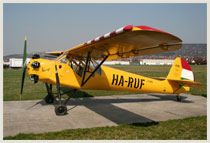
| Technical data: | |
| Wing-span: | 11,6 m |
| Wing area: | 14,37 m2 |
| Length of the plane with radial engine: | 7,5 m |
| Length of the plane with reciprocating engine: | 8,3 m |
| Height: | 2,5 m |
| Weight of the empty plane: | 650 kg |
| Maximum speed: | 200 km/h |
| Cruising speed: | 125 km/h |
| Maximum climbing ability near to the ground, alone, with reciprocating engine: | 3 m/sec |
| Maximum climbing ability of the towing plane: | 1,5 m/sec |
| Stalling speed: | 65 km/h |






